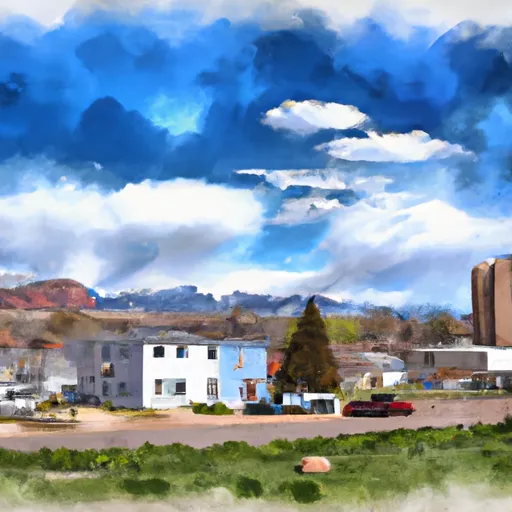-
 Snoflo Premium
Snoflo Premium
Get unlimited access to all our content
With no Ad interruptions! - Start Your Free Trial Login with existing account
Hayden
Eden Index
Climate
7.3
•
Recreation
2.7
•
Community
2.7
•
Safeguard
4.5/10

Hayden is a small town located in northwestern Colorado, with a population of around 2,200 people. The town experiences a semi-arid climate, characterized by hot summers and cold winters. The Yampa River flows through the town, providing a source of water for irrigation and recreation. The river is also home to various hydrology constituents, including trout and other fish species. Outdoor recreation opportunities in Hayden include hunting, fishing, hiking, and skiing. The nearby Steamboat Ski Resort offers world-class skiing and snowboarding, while the Yampa River State Park provides opportunities for camping, picnicking, and boating. Overall, Hayden is a great destination for those who enjoy outdoor activities, and the town's natural beauty is sure to be appreciated by visitors.
What is the Eden Index?
The Snoflo Eden Index serves as a comprehensive rating system for regions, evaluating their desirability through a holistic assessment of climate health, outdoor recreation opportunities, and natural disaster risk, acknowledging the profound impact of these factors on livability and well-being.
Climate Health Indicator (CHI): 7.3
Hayden receives approximately
460mm of rain per year,
with humidity levels near 63%
and air temperatures averaging around
7°C.
Hayden has a plant hardyness factor of
4, meaning
plants and agriculture in this region thrive during a short period during spring and early summer. Most
plants will die off during the colder winter months.
By considering the ideal temperature range, reliable water supplies, clean air, and stable seasonal rain or snowpacks, the Climate Health Indicator (CHI) underscores the significance of a healthy climate as the foundation for quality living.
A healthy climate is paramount for ensuring a high quality of life and livability in a region, fostering both physical well-being and environmental harmony. This can be characterized by ideal temperatures, reliable access to water supplies, clean air, and consistent seasonal rain or snowpacks.
Weather Forecast
Streamflow Conditions
White - Yampa
Area Rivers
White - Yampa
Snowpack Depths
White - Yampa
Reservoir Storage Capacity
White - Yampa
Groundwater Levels
Recreational Opportunity Index (ROI): 2.7
The Recreational Opportunity Index (ROI) recognizes the value of outdoor recreational options, such as parks, hiking trails, camping sites, and fishing spots, while acknowledging that climate plays a pivotal role in ensuring the comfort and consistency of these experiences.
Access to outdoor recreational opportunities, encompassing activities such as parks, hiking, camping, and fishing, is crucial for overall well-being, and the climate plays a pivotal role in enabling and enhancing these experiences, ensuring that individuals can engage in nature-based activities comfortably and consistently.
Camping Areas
| Campground | Campsites | Reservations | Toilets | Showers | Elevation |
|---|---|---|---|---|---|
| Himes Peak | 11 | 8,794 ft | |||
| Deep Lake | 35 | 10,475 ft | |||
| East Marvine | 7 | 8,114 ft | |||
| Trappers Lake | 35 | 9,747 ft | |||
| Marvine | 22 | 8,164 ft | |||
| Supply Basin | 7 | 10,767 ft | |||
| Vaughn Lake | 6 | 9,474 ft | |||
| Sweetwater Lake | 9 | 7,739 ft | |||
| Chapman Reservoir | 12 | 9,269 ft | |||
| Trout Creek | 6 | 8,164 ft |
Nearby Ski Areas
Catastrophe Safeguard Index (CSI):
The Catastrophe Safeguard Index (CSI) recognizes that natural disaster risk, encompassing floods, fires, hurricanes, and tornadoes, can drastically affect safety and the overall appeal of an area.
The level of natural disaster risk in a region significantly affects safety and the overall livability, with climate change amplifying these risks by potentially increasing the frequency and intensity of events like floods, fires, hurricanes, and tornadoes, thereby posing substantial challenges to community resilience and well-being.
Community Resilience Indicator (CRI): 2.7
The Community Resilience Indicator (CRI) recognizes that education, healthcare, and socioeconomics are crucial to the well-being of a region. The CRI acknowledges the profound impact of these elements on residents' overall quality of life. By evaluating educational resources, healthcare accessibility, and economic inclusivity, the index captures the essential aspects that contribute to a thriving community, fostering resident satisfaction, equity, and social cohesion.

